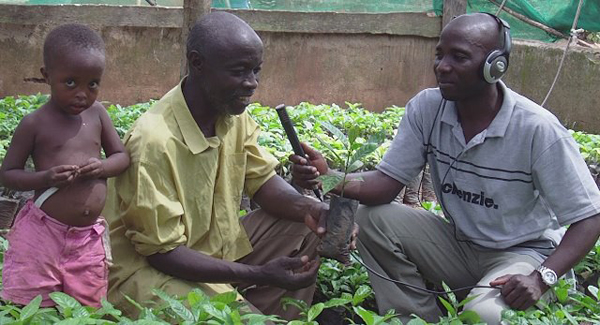Jaime Little | October 16, 2017
Like many maize farmers in central Uganda, Peter Balaba was dismayed to find Fall armyworm caterpillars in his fields again this season.
In addition to tending his four acres of maize, Mr. Balaba produces farmer programs at Nakaseke Radio, about 65 kilometres north of the capital, Kampala. During last season’s drought, he interviewed dozens of farmers and saw first-hand what can happen when they don’t have reliable information during a crisis. This season, he and his radio team are doing everything they can to ensure that farmers will be better prepared.
Mr. Balaba says: “[Fall armyworm] came at a time when many farmers didn’t know much about it, or how to combat it. And many of them were very poor, too poor to buy the right pesticides. Because of that, there was a delay to combat it. It spread from one village and one farm to another.”
And spread it did, as much as 100 kilometres per night. The caterpillars destroyed whole maize fields, causing shortages and price hikes during the May harvest. Before the Fall armyworm crisis, a kilogram of maize cost between 500 and 800 Uganda shillings (US$0.14 to 0.22). Now, it costs double or triple that much.
Months after that meagre harvest, when the caterpillars reappeared on this season’s maize stalks and cobs, farmers feared the worst.
They scrambled to find ways to get rid of them—some bought expensive pesticides, others sprayed their fields with paraffin to try to stop the caterpillars in their tracks. But paraffin damaged their spray pumps.
Mr. Balaba and his team at Nakaseke Radio saw that farmers needed accurate, up-to-date information. They sprang into action, broadcasting both on the radio and online to spread messages faster and farther than even the Fall armyworm could travel.
He explains: “As a radio station, we approached the extension workers. They had knowledge about it, so we hosted them in our studios. They created awareness and suggested pesticides to use. Of course we also went to the field to see what was happening.”
He says that during field visits, extension workers saw that some pesticides were ineffective, and suggested alternatives. Nakaseke Radio broadcast those recommendations immediately.
About 40,000 people in central and northern Uganda listen to Nakaseke, a Farm Radio International broadcasting partner. One of the station’s popular programs is Enkumbi Terimba, meaning “A Hoe Doesn’t Lie.” It airs twice a week and deals with farmers’ top challenges and concerns. The program has been talking a lot about Fall armyworm this year.
Nakaseke’s radio producers not only took to the airwaves—they also turned to social media. They used their Facebook page and a WhatsApp group to get the message out as quickly and widely as possible.
Mr. Balaba explains: “As we went to the field, we took photos. Of course, not every farmer is on social media, but there are people in the community who have smartphones and who are following our page. So we posted and then we got their feedback. They would tell us ‘It is also here,’ or ‘We have seen it in different places.’ And we would go there, and try to give them some solutions.”
The station posted the latest information and management tips on a district-wide WhatsApp group that includes government officials, extension workers, political leaders, and farmers.
Mr. Balaba says the radio station’s social media campaign started a dialogue with farmers and other experts who chimed in with their experiences and suggestions.
He adds, “The feedback was very positive. Farmers were also giving some solutions to the problems; extension workers in the group were also giving contributions, as well as NGO members.”
In Uganda, 3.6 million households depend on maize. The Ugandan government is expecting losses of at least 450,000 tonnes this year, worth almost $2 million US.
The rains started just last week in central Uganda. Mr. Balaba is hoping that this will slow the spread of Fall armyworm, and give farmers like him a chance to put the latest recommendations into action to protect their crops.
Photo: Armyworm in a maize stalk
